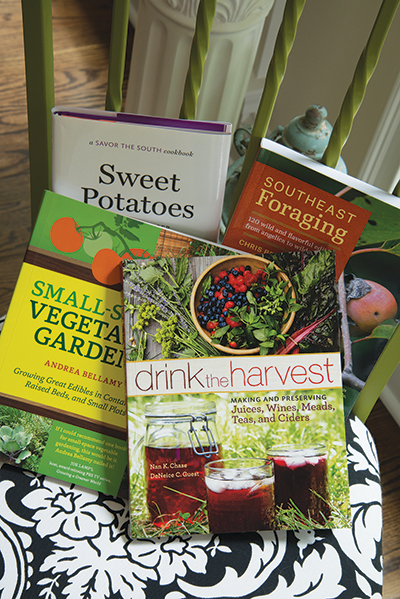Christmas is right around the proverbial corner, and the urge to find perfect gifts for friends and family members is ramping up. For those gardeners on your list, tillers, shovels, bird baths and pole pruners are great ideas, but they can be real bears to decorate in seasonal wrapping paper.
So, consider books — backyard growers always enjoy the latest in gardening literature and besides, they are SO much easier to wrap!
Need suggestions? Below are four recently published possibilities for those deserving gardeners on your gift list:
Drink the Harvest by Nan Chase and DeNeice Guest (Storey Publishing, 224 pages, $18.95 paperback). Did you know drinking can be the new eating when it comes to nourishing ways to enjoy garden crops?
Ciders, wines, teas, meads and syrups are all covered with recipes using the usual suspects such as grapes, peaches, pears, apples and blueberries, but then there are the interesting alternatives. Spiced ginger-bay syrup, anyone? Prickly pear cactus juice, maybe? Or perhaps a refreshing parsley wine? Whatever your pleasure, raise your glass to healthy drinking from the garden!
Small-Space Vegetable Gardens by Andrea Bellamy (Timber Press, 214 pages, $19.95 paperback). Budding vegetable gardeners are often nipped by their apparent lack of space to grow plants, but this book demonstrates that size indeed doesn’t matter, by exploring the practicalities of growing veggies in small areas, raised gardens and even pots. Although the author is a Vancouver, Canada, grower, her ideas for making the most out of the least space translate well for Southern gardeners.
Sweet Potatoes by April McGreger (UNC Press, 136 pages, $18 hardback). Sweet potatoes have been a standard in Southern veggie patches for centuries, and why not? They are easy to grow, nutritious, and as made obvious by McGreger, can be delicious in many ways. Her culinary ideas include these tasty tubers as main ingredients in soups, stews, side dishes, main courses, salads and breakfast fixin’s. This book is a new addition to UNC Press’ popular Savor the South series, which also added two more recent introductions, Beans and Field Peas by Sandra Gutierrez and Sunday Dinner by Bridgette Lacy.
Southeast Foraging by Chris Bennett (Timber Press, 296 pages, $24.95 paperback). Beyond the cultivated backyard gardens of fruits and vegetables in the Southeast, more edibles await in the wild — you just have to know what and where these indigenous munchies are. Many such teachable moments can be found in Bennett’s informative book, which is a fun guide down the woodland path to discover definitely different, safe-to-eat native plants.
L.A. Jackson is the former editor of Carolina Gardener Magazine. Want to ask L.A. a question about your garden? Contact him by email at lajackson1@gmail.com.
To Do in the Garden
November
- Frost is not completely unwelcome in the fall vegetable garden. This is especially the case with cole crops such as broccoli, brussels sprouts, cabbage and cauliflower, because a nipping from Jack Frost will turn some of the vegetable starch in the plants into sugar and make them sweeter tasting.
- Prune back cannas and discard this year’s foliage to cut down on the population of leaf rollers that can overwinter in leftover leaves and emerge next spring to continue their destructive, plant-chewing ways.
- Back still throbbing from carrying in large whiskey barrel planters for the winter? For a good cold weather project, add caster wheels to the bottoms of the heavy containers, which will make moving them much easier.
- Grouping potted houseplants together indoors will conserve a bit more humidity to help them counteract the dry air typically found in warm winter homes.
December
- You did start a compost pile this fall, didn’t you? To prevent cold winter rains from slowing the decomposition process, cover the pile with a plastic sheet. This has the extra advantage of collecting and trapping more heat from the sun.
- Add mulch around newly planted evergreens and water them during extended dry periods. Even in winter, drought can be a problem for these woody ornamentals.
- Tubes from Christmas wrapping paper can be snipped into 4-inch-long sections and recycled in next year’s spring garden as cutworm collars to protect young annuals.
- Rotate African violets a quarter turn every two weeks to prevent the plants from growing off-center as they lean toward their light source.
- Inspect houseplants periodically this winter for signs of insect activity and dispatch any immature invaders before they can become a full-blown infestation.

Timely Tip
If you receive an amaryllis bulb as a Christmas gift, and it has not sprouted or bloomed yet, to encourage a show of flowers indoors this winter, remember the key is to crowd it. The space between the bulb and the edges of the pot should be no more than an inch.
Also, the heavier the pot, the less likely this tall beauty will tip over easily when it reaches its full height and begins to blossom.
To help the blooms last longer, keep the plant away from dry air drafts that come from heating vents during the cold months.







